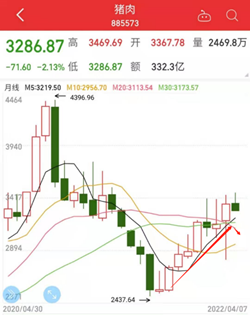

China’s publicly traded hog companies suffered a major selloff on Friday. China Pork Index 885573, which tracks 30+ companies in the hog sector, dropped 2.13%, while the overall Shanghai Stock Index went up 0.47% to 3251.85.


Kingsino (002548) led the downfall with its stock price limit down at -10% on Friday. Tiankang Biotech (002100) fell over 5%. Tianbang (002124), TRS (002567) and New Hope (000876) each dropped 4% or more. Wen’s Group (300498), Huatong (002840), Juxing (002444), Zhenghong (000702), Muyuan (002714) and Aonong (603363) all lost over 3%. Zhengbang (002157), DBN (002385) and Shuanghui (000895) declined by 2%.
With ample hog supply and weak pork demand, China’s hog price ended a short-lived rebound. Farm level hog price averaged RMB 12.54 per liveweight kilogram on April 8, down 45% from a year ago, according to price data tracked by CACDA. This is equivalent to 89.42 cent per liveweight pound. (Current exchange rate US$1=RMB6.37).
Last week, China’s state reserve bought 40,000 tons of frozen pork in open auctions held on April 2-3. This apparently did nothing to support the falling pork price.
The Top-5 hog producers have all released their March hog sales data this week. Muyuan, the No. 1 hog producer in the world, sold 5.99 million hogs, up 111% year-on-year. However, hog sales revenue fell 39.5% to 7.43 billion yuan for the same period. Muyuan reported an average hog sales price at 11.67 yuan/kg in March, significantly below the break-even point of 16 yuan disclosed by the Company earlier.
Wen’s Group sold 1.45 million hogs and booked 2.11 billion yuan in revenue, up 144% and 14.3% over March 2021, respectively. The Company reported March average hog sales price of 12.17 yuan, down 3.03% month over month, and -53.55% year-on-year.
New Hope Group came in the close No. 3, with March hog sales of 1.43 million (+67%) and revenue of 1.69 billion (-22.3%). March sales price of 11.64 is +2.19% above February, but -50.47% over March 2021.
Zhengbang had hog sales of 967K (-6.8%) and revenue of 980M (-65%). It is the only Top-5 firm with declining monthly hog sales. Tianbang sold 336K hogs (+1.1%) and booked revenue of 494M (-42%).
The above sales and revenue data all comes from company public release information.
China’s hog price gradually moved up about 15% from mid-March to early April, giving industry hope that a new hog cycle is underway. However, disappointing holiday retail market during the Qingming Festival (April 5th) shed doubt on meat demand rebound.
As of this writing, Shanghai, the largest Chinese city with a population of 26 million is in the third week of complete citywide lockdown. Guangzhou, population 18 million, is at the beginning of a lockdown. There is rumor that much of China’s highway system is being locked down to slow the spread of Covid. Economic engines are turned off. Most residents are trapped inside their home. Some are transported to government quarantine facilities if they tested positive or have been in contact with someone who did.
While hog price is at record low at farm level, the COVID restrictions make it extremely difficult to process the pork and move it from farm to retail delivery. Homebound citizens have limited food to eat and must pay a huge price when they do get any.
On the supply side, the continuous expansion among big producers shook up investor confidence on anticipated hog and sow liquidation. According to China Statistics Bureau, total sow stock was 42.7 million at the end of February. While this is 6.5% below June 2021 level, it is still 4% above 41 million sows, which are considered supply/demand equilibrium by the Government.
The futures market echoed in agreement. The May 2022 contract of Dalian Commodity Exchange’s live hog futures closed at 12,675 (yuan per ton). This is down 525 points, or 4.0% from the high of 13,200 it reached on April 1st. The January 2023 contract, which corresponds to the Spring Festival sales season, closed at 18,765, down 470 points.
What the futures price now predicts is that by the end of the year, only the biggest and most cost-efficient hog producers could reach breakeven. Most Chinese farmers will have to wait till next year for hog margin to turn positive.
Jim W. Huang, CFA
Email: jimwenhuang@gmail.com





